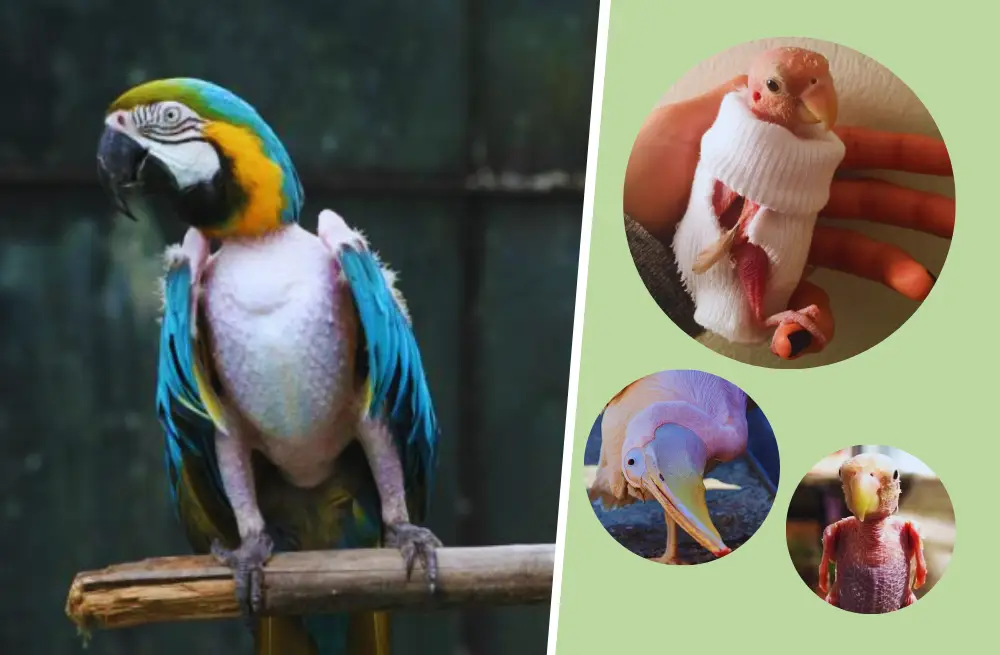Wondering if sugar gliders have a pouch? The answer to this questions is: Yes, female sugar gliders have a pouch, just like other marsupials such as Kangaroos! This pouch is located on the abdomen of the female glider and serves a crucial role in carrying and nurturing their young joeys.
After birth, the tiny and underdeveloped joeys crawl into the pouch where they attach themselves to the mother’s teats for nourishment and further growth. The pouch provides a secure and warm environment, ensuring the safety and well-being of the joeys as they continue to develop. It allows the mother to easily care for her offspring, keeping them close and protected until they are ready to explore the outside world on their own.
The pouch is an amazing adaptation that highlights the unique reproductive strategy of sugar gliders and their close resemblance to other marsupials.
Keep reading to understand more about sugar gliders and why they have a pouch!
What are Sugar Gliders?
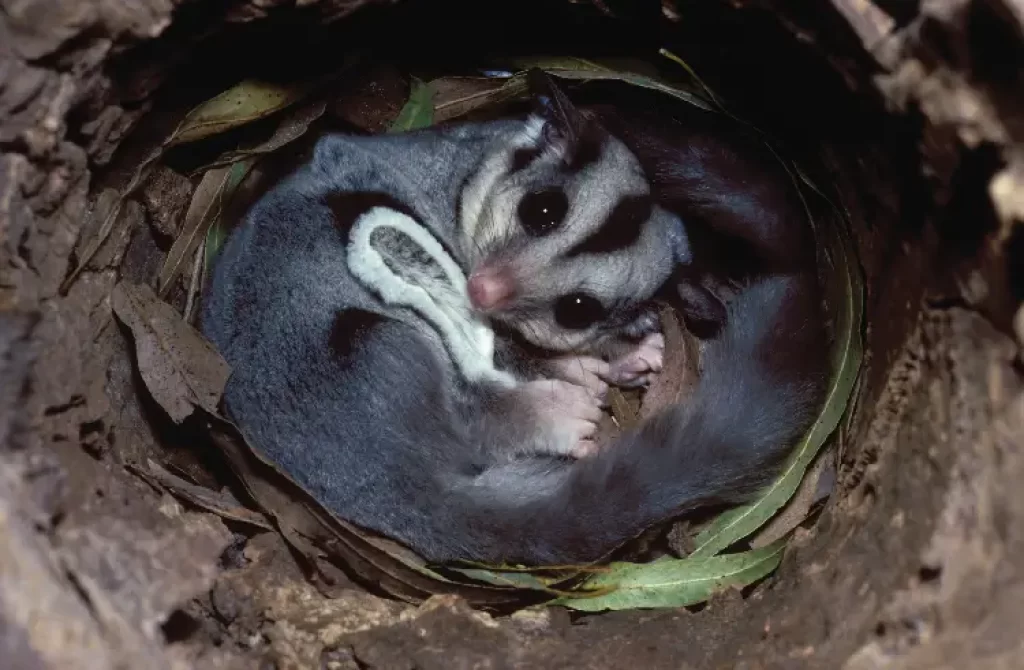
The sugar glider, scientifically referred to as Petaurus breviceps, is a captivating marsupial native to southeastern Australia. These small creatures possess a range of remarkable adaptations that enable them to thrive in their arboreal habitat.
Sugar gliders are omnivorous and nocturnal, displaying a unique ability to glide through the air, reminiscent of flying squirrels, although they are not closely related. This phenomenon of similar adaptations arising independently is known as convergent evolution and underscores the fascinating diversity of nature.
Sugar gliders possess gliding membranes called patagia that extend from their forelegs to their hindlegs, enabling them to glide through the air with remarkable agility.. These patagia allow them to glide effortlessly through the forest canopy, facilitating efficient foraging and evading potential predators. Their fur is soft and ranges in color from pale grey to light brown, exhibiting countershading.
This coloration adaptation helps them blend into their surroundings, with lighter tones on the underside to minimize their visibility against the sky.
Sugar gliders primarily inhabit southeastern Australia, specifically regions such as southern Queensland and most of New South Wales east of the Great Dividing Range.
Anatomy of the Pouch
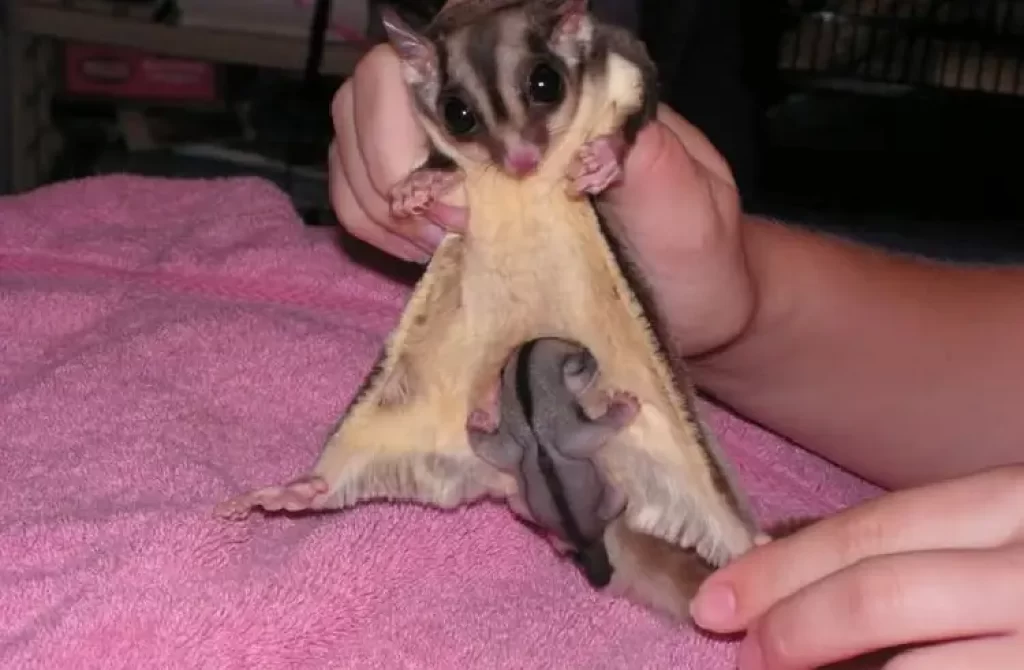
The pouch of a female sugar glider is a skin fold located on her belly. It is created by a fusion of the lateral edges of the marsupial’s abdominal muscles, forming a pocket-like structure. The pouch is lined with fur, providing a warm and comfortable environment for the sugar glider’s young, known as joeys.
Reproduction and Pouch Usage
Sugar gliders exhibit unique reproductive characteristics that contribute to their fascinating life cycle. After successful mating, the female sugar glider undergoes a relatively short gestation period of approximately 16 to 17 days, which is remarkably brief compared to many other mammals. This short gestation period reflects the sugar gliders’ ability to rapidly develop their young and adapt to their environment.
Following the gestation period, the female sugar glider gives birth to tiny, underdeveloped joeys. At birth, the joeys weigh only around 0.2 grams, making them incredibly small and vulnerable.
They are also blind and hairless, lacking the physical capabilities to survive independently. Instead, they rely entirely on their mother for nourishment, protection, and guidance.
You might also like: How to Determine the Gender of Your Pet Sugar Glider
Inside the Pouch
Inside the pouch of a female sugar glider, a fascinating journey unfolds for the joeys. It serves as a nurturing space, providing the essential care and nourishment they need to thrive. Let’s take a closer look at what happens inside the pouch.
Shortly after birth, the tiny joeys, weighing only a fraction of a gram, begin their remarkable adventure. Guided by their natural instincts and the mother’s licking behavior, they crawl their way into the pouch. It is an incredible display of determination and survival instinct as they navigate their way to safety.
Once inside the pouch, the joeys encounter a warm and secure environment. The mother’s pouch offers protection from external elements and predators, creating a cozy haven for their growth and development. It is within this pouch that they will spend a significant portion of their early life.
The pouch of a female sugar glider contains four teats, each capable of providing nourishment to a joey. The joeys locate and latch onto one of these teats, ensuring a direct connection to the mother’s milk supply. The teats serve as a vital source of nutrition, delivering the necessary sustenance for their rapid growth.
Milk from the mother’s teats is rich in essential nutrients, including proteins, fats, and sugars, crucial for the joeys’ development. As they suckle, they receive the nourishment required to strengthen their bodies and develop into healthy individuals. It is within the pouch that they undergo significant growth milestones, transitioning from tiny, underdeveloped creatures to thriving joeys.
During their time inside the pouch, the joeys also receive maternal care and attention. The mother groomes them, ensuring their cleanliness and well-being. She ensures their comfort and provides a sense of security, allowing them to grow and develop in a nurturing environment.
As the joeys mature and reach a certain stage of development, they gradually start venturing out of the pouch. This marks an exciting milestone in their lives as they begin to explore the world beyond the safety of their mother’s pouch. With time, they become more independent and start experiencing the wonders of the surrounding environment.
The pouch of a female sugar glider plays a vital role in the early life stages of their offspring. It provides a safe and nurturing space, offering warmth, protection, and a direct supply of nourishment.
The incredible bond between a mother sugar glider and her joeys is exemplified within this pouch!
Pouch Development and Adaptations
Within the pouch, the joeys experience rapid growth and undergo various developmental changes. Over time, they develop fur, their eyes open, and they become more mobile. As they grow, the joeys spend increasing amounts of time outside the pouch, venturing out to explore their surroundings and gradually gaining independence.
Pouch Functions and Benefits
The pouch plays multiple vital roles in the life of a female sugar glider. Firstly, it offers a safe and protected environment for the joeys, shielding them from external threats such as predators. Secondly, the pouch provides warmth and security, ensuring optimal conditions for the joeys’ growth and development. Additionally, the pouch allows the mother to conveniently carry her young while she moves, hunts, or forages for food.
Maternal Care and Parental Investment
Female sugar gliders are exceptional caregivers, displaying high levels of parental investment. They invest considerable time and energy in nurturing their young. The pouch enables the mother to maintain close contact with her joeys, ensuring their well-being and providing nourishment whenever required. The mother’s continuous presence and care within the pouch create a strong bond between her and the joeys.
Male Sugar Gliders and Pouch Absence
While the pouch is a distinguishing feature of female sugar gliders, it is absent in their male counterparts. The absence of a pouch in male sugar gliders is a notable characteristic that aligns with their distinct roles in the reproductive process.
In the sugar glider society, males have different responsibilities compared to females. Their primary focus is on mating and providing protection and resources to the female and her offspring. They play a vital role in ensuring the survival and well-being of the family unit.
Without a pouch, male sugar gliders are not involved in carrying and caring for the joeys directly. Instead, they contribute to the survival of the young by safeguarding the nest, defending against potential threats, and providing food and support to the female and her offspring.
The absence of a pouch in male sugar gliders does not diminish their importance in the reproductive journey of the species. Their presence and involvement are crucial for the overall success and stability of the sugar glider population.
Significance of the Pouch in Sugar Gliders
The pouch of a sugar glider showcases the remarkable adaptability and diversity of marsupials. It represents a unique feature that distinguishes sugar gliders from other mammals. The pouch’s existence and functionality highlight the extraordinary strategies employed by these creatures to ensure the survival and successful reproduction of their species.
Significance of the Pouch in Sugar Gliders
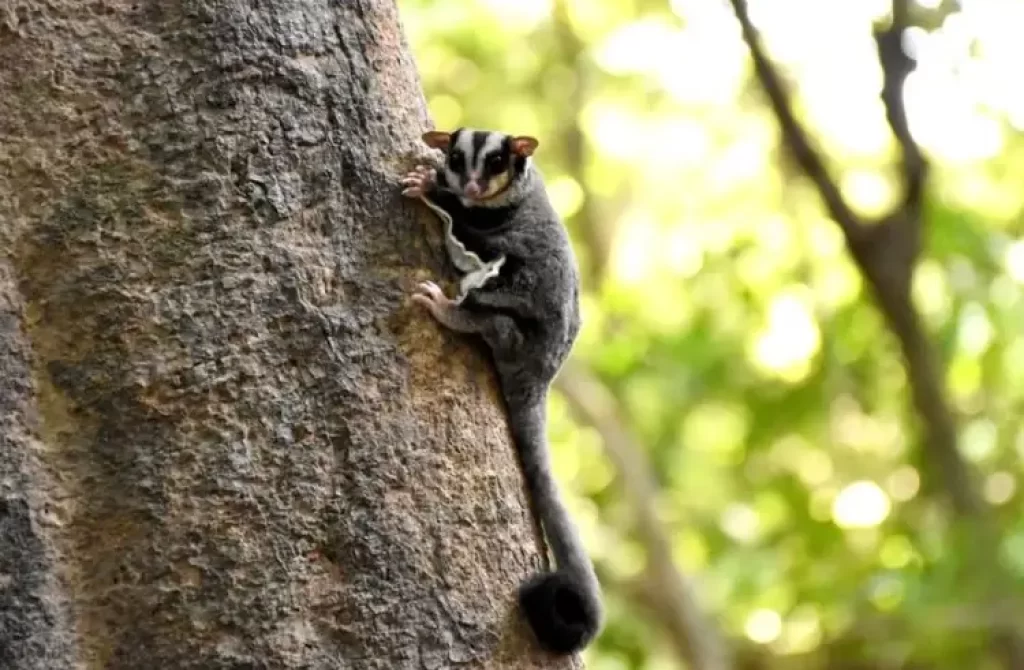
The pouch of a sugar glider showcases the remarkable adaptability and diversity of marsupials. It represents a unique feature that distinguishes sugar gliders from other mammals. The pouch’s existence and functionality highlight the extraordinary strategies employed by these creatures to ensure the survival and successful reproduction of their species.
Conservation Considerations
Understanding the pouch’s significance in sugar gliders is crucial for their conservation. Habitat loss, deforestation, and other human activities pose threats to sugar glider populations. By appreciating and conserving their natural habitats, we can help safeguard these enchanting marsupials and the fascinating adaptations, such as the pouch, that make them so special.
Conclusion
The pouch of a female sugar glider is an extraordinary adaptation that facilitates their reproductive success and the survival of their young. This specialized structure exemplifies the intricate complexities of nature and the diverse ways in which animals have evolved to meet the challenges of their environments. The pouch of the sugar glider is not only a marvel of biology but also a testament to the resilience and resourcefulness of these captivating creatures.
Up Next:
- Sugar Glider (Petaurus breviceps)
- What Do Wombats Eat?
- Owning a Sugar Glider
- How Much Does a Kangaroo Eat Per Day?
- How to Determine the Gender of Your Pet Sugar Glider
FAQ
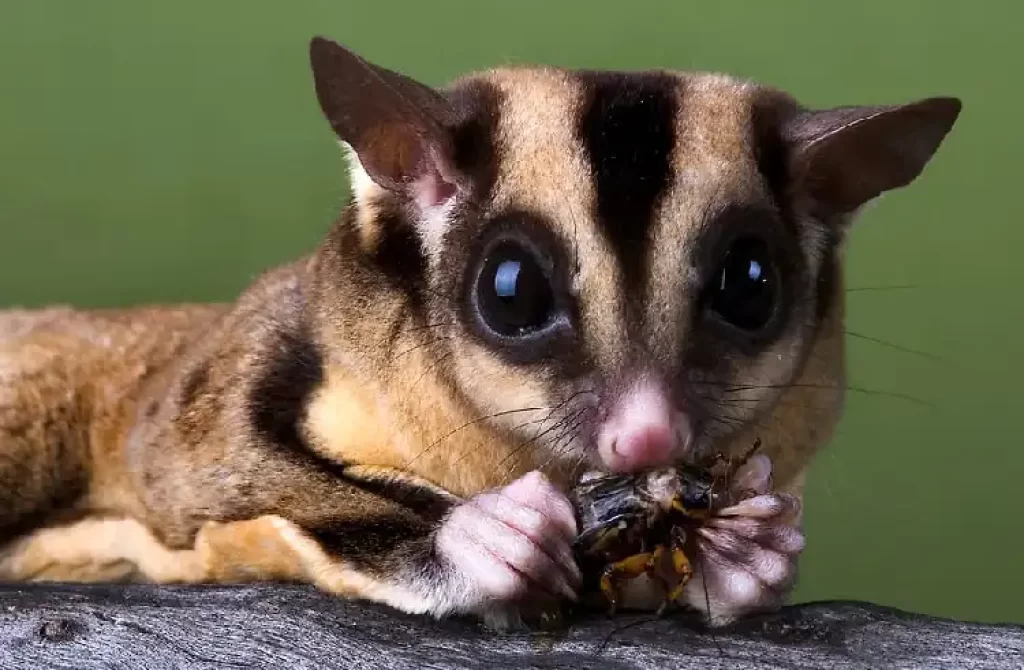
Do all sugar gliders have pouches?
No, only female sugar gliders have pouches. The pouch is a unique feature of female marsupials, including sugar gliders. It serves as a specialized structure for carrying and nurturing their young, known as joeys. Male sugar gliders do not possess pouches as their reproductive roles differ from females.
Is sugar glider marsupial?
Yes, sugar gliders are marsupials. Marsupials are a group of mammals that give birth to relatively undeveloped young, which then continue to grow and develop inside a pouch. The female sugar glider has a pouch where the newborn joeys crawl into after birth. They attach themselves to the mother’s teats and continue to develop and nurse inside the pouch until they are ready to venture out on their own.
Can I keep 1 sugar gliders as pets?
Yes, it is possible to keep a sugar glider as a pet. However, it’s important to note that sugar gliders have specific care requirements and are not recommended for inexperienced pet owners. They are social animals and thrive best when kept in pairs or small groups.
They need a large enclosure with plenty of vertical space for climbing, as well as a varied diet that includes fresh fruits, vegetables, protein, and specialized sugar glider food. Sugar gliders also require regular social interaction and mental stimulation to ensure their well-being.
It’s essential to research and understand their needs before considering them as pets, and it’s advisable to consult with a veterinarian who has experience with sugar gliders.
How do you know if a sugar glider has Joeys?
Determining if a sugar glider has joeys can be challenging as they keep them hidden in their pouch. Signs may include an enlarged abdomen, prominent nipples, maternal behaviors, distinct vocalizations, or observing pouch entry with caution. Remember to respect their privacy and avoid unnecessary disturbance.




